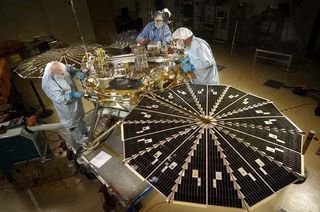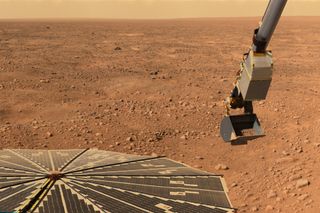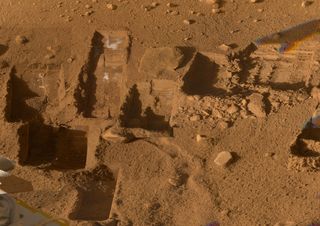Phoenix Mars Lander: The First Spacecraft to Taste Martian Water
On May 25, 2008, NASA's Phoenix Mars Lander blazed through the Martian atmosphere and landed at the northern pole of the Red Planet. The spacecraft made history as its robotic arm was the first to touch and sample water on Mars. During the lander's three months on the Red Planet, Phoenix revealed an unprecedented amount of information about the Martian environment.
"Phoenix has given us some surprises, and I'm confident we will be pulling more gems from this trove of data for years to come," Principal Investigator Peter Smith of the University of Arizona in Tucson said in a 2008 statement at the end of the lander's lifetime.
"Phoenix provided an important step to spur the hope that we can show [that] Mars was once habitable and possibly supported life," said Doug McCuistion, then-director of the Mars Exploration Program at NASA Headquarters in Washington, D.C.
A "hard and risky" mission
In 2002, NASA's Mars Odyssey Orbiter revealed large amounts of subsurface water ice in the Martian arctic. Because of that, the Phoenix spacecraft was designed to include a robotic arm capable of digging through the protective topsoil layer to the water ice below.
The Phoenix lander was designed by Lockheed Martin Space Systems in Denver and was named after the mythical bird that regenerates from the ashes of its own death. The name was well-suited, as the designers created the spacecraft by repurposing the Mars Surveyor 2001 lander, which had been canceled. Phoenix also carried a complex suite of instruments, which were improved versions of the ones that flew on the lost Mars Polar Lander mission.

On Aug. 4, 2007, Phoenix launched from Cape Canaveral Air Force Station in Florida aboard a Delta II rocket. After a nine-month voyage, the spacecraft barreled into the Martian atmosphere on May 25, 2008.
"This is not a trip to Grandma's house," Ed Weiler, then-associate administrator of NASA's Science Mission Directorate at the agency's headquarters in Washington, D.C., told Space.com before the landing. "Putting a spacecraft safely on Mars is hard and risky."
During what the spacecraft's team called its "7 minutes of terror," Phoenix plunged into the Martian atmosphere at about 13,000 mph (21,000 kph) as mission control waited tensely to hear that the spacecraft had safely reached the ground. A Viking-era parachute opened when the spacecraft was 7.8 miles (12.6 kilometers) above the surface, slowing the descent. Phoenix safely touched down in the arctic plains region of Mars, called Vastitas Borealis, which was the farthest north any spacecraft had landed on the Red Planet.
Above and beyond
The Phoenix spacecraft's specialized robotic arm dug through an ice-rich layer to form shallow trenches on the Martian terrain. The arm carried samples from the ground into the tiny ovens and miniature laboratory aboard the spacecraft. Selected samples were heated to release elements that were examined for their chemical and physical characteristics.
Phoenix also carried a stereo camera on its 6.6-foot (2 meters) mast. The camera collected more than 25,000 pictures, including several sweeping panoramas. Images were also taken with the first atomic-force microscope ever used outside Earth.
The Phoenix spacecraft was a lander not a rover, and as such, it never moved from its landing site. It remained stationary during the three months of its primary mission and continued to work for more than two additional months. The spacecraft went into hibernation mode after Mars arrived at a point in its orbit where the sun was positioned too low in the sky to continue powering the spacecraft's solar cells. At that time, a dust storm also blocked what little of the sunlight managed to pierce the clouds.
But NASA didn't give up on the little lander just yet. The agency's Mars Odyssey Orbiter continued to listen for signals while flying over Phoenix. As the sun rose again on the northern plains several months later, Odyssey swooped over the landing site as many as 10 times a day for three consecutive days in January 2009. It then engaged in two longer listening campaigns in February and March.
The Phoenix spacecraft's hardware was not designed to survive the temperature extremes and heavy coats of ice from a harsh Martian winter. Phoenix was programmed to attempt to make contact if it managed to survive, but the spacecraft remained silent.
Almost a decade after the Phoenix mission ended, NASA's Mars Reconnaissance Orbiter snapped a photo showing the lander, its back shell and its parachute. A comparison of the image with one taken soon after the Phoenix landing showed that dust had covered the landing scars the spacecraft previously etched on the Martian surface.

Phoenix science
Phoenix's study of Mars resulted in a long list of revolutionary discoveries about the planet. One of the most notable came on July 31, 2008, when the spacecraft confirmed the presence of water ice on Mars after successfully collecting a soil sample containing ice from a trench 2 inches (5 centimeters) deep. The historic discovery marked the first time water was sampled on the Red Planet.
But Phoenix didn't stop with the discovery of water ice; it also found snow. A laser instrument designed to study the planet's atmosphere detected snow from clouds about 2.5 miles (4 km) above the spacecraft's landing site, but the snow vaporized before it touched the ground.
"Nothing like this view has ever been seen on Mars," researcher Jim Whiteway said in a 2008 statement. Whiteway, of York University in Toronto, was the lead scientist for the Canadian-supplied Meteorological Station on Phoenix. "We'll be looking for signs that the snow may even reach the ground," he said.
Indeed, researchers determined that later into the Martian winter, precipitation likely results in a buildup of water ice on and in the ground.
Experiments on the lander also revealed signs of calcium carbonate, the main component of chalk, along with particles that could be clay.
Phoenix's data collection also suggested that the soil in the arctic plains was covered with a film of liquid water in the last few million years. The evidence for water and potential nutrients "implies that this region could have previously met the criteria for habitability" during portions of continuing climate cycles, researchers wrote in a 2009 paper published in the journal Science.
The mission's biggest surprise was the discovery of perchlorate in the Martian soil. A chemical that strongly attracts water, perchlorate made up a few tenths of a percent of the composition of all three soil samples analyzed by Phoenix's laboratory. That water could have been pulled directly from humid Martian air, or liquid water beneath the crust could have combined with salts as a brine that stays liquid at Martian surface temperatures.

Phoenix's legacy
The Phoenix spacecraft provided unprecedented insight into Earth's reddest neighbor, and the mission was considered a success.
"Before Phoenix, we did not know whether precipitation occurs on Mars," said Whiteway in a 2009 statement. "We knew that the polar ice cap advances as far south as the Phoenix site in winter, but we did not know how the water vapor moved from the atmosphere to ice on the ground. Now, we know that it does snow and that this is part of the hydrological cycle on Mars."
Although the mission is over, the legacy of Phoenix continues, as researchers will spend the next several years unraveling even more Martian mysteries by delving through the wealth of data the spacecraft provided.
Additional resources:
- NASA's overview of the Phoenix mission.
- Read more about the Phoenix mission on the University of Arizona's Phoenix Mars Mission page.
- Check out this Mars Phoenix photo gallery compiled by Views of the Solar System.
Join our Space Forums to keep talking space on the latest missions, night sky and more! And if you have a news tip, correction or comment, let us know at: community@space.com.
Get the Space.com Newsletter
Breaking space news, the latest updates on rocket launches, skywatching events and more!

Nola Taylor Tillman is a contributing writer for Space.com. She loves all things space and astronomy-related, and enjoys the opportunity to learn more. She has a Bachelor’s degree in English and Astrophysics from Agnes Scott college and served as an intern at Sky & Telescope magazine. In her free time, she homeschools her four children. Follow her on Twitter at @NolaTRedd
